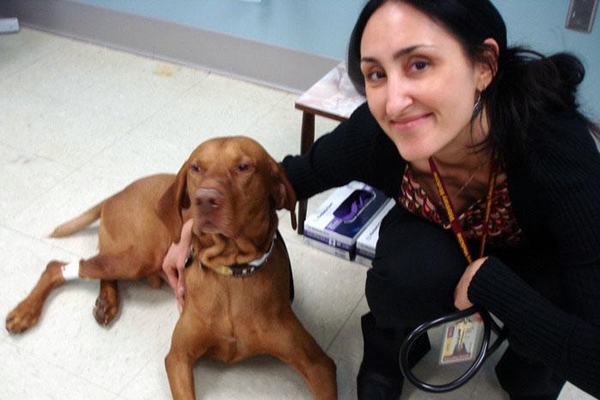14 February 2017. A drug to treat a deadly cancer in dogs was shown in a clinical trial to extend the survival time of canine patients by 6 months or more, with potential applications in humans. The team from University of Minnesota veterinary medical school published its findings in the 13 February issue of the journal Molecular Cancer Therapeutics.
A team led by veterinary cancer specialist Antonella Borgatti is seeking better treatments for canine hemangiosarcoma or HSA, an aggressive cancer of the blood vessels that spreads quickly in the body. Canine HSA appears on the skin and in the spleen, although other organs such as liver, lungs, and kidney may be affected. When HSA appears in the spleen, surgical removal of the organ is the usual treatment. But according to the National Canine Cancer Foundation, the prognosis for patients with HSA in the spleen is dire, with survival ranging from 19 to 86 days.
In the study, the researchers evaluated a drug known as eBAT developed by Minnesota pharmacology colleague and senior author Daniel Vallera. eBat is a combination of cancer-killing toxin derived from Pseudomonas bacteria, a microbe associated with infections contracted in health care facilities, and epidermal growth factor, a protein that regulates cell growth. The drug also adds in a protein derived from kidney cells that targets receptors for urokinase plasminogen activator proteins implicated in both tumor development and growth of blood vessels that support the tumors.
Like some cancer drugs for humans, treatments for canine cancers can also be difficult for patients. “eBAT was created to specifically target tumors while causing minimal damage to the immune system,” says Vallera in a university statement, adding that “eBAT was selected for this trial because it can simultaneously target the tumor and its vascular system.”
The clinical trial tested eBAT in 23 dogs of large and small breeds with HSA in their spleens that already had surgery to remove the organ. Participants received 3 eBAT treatments, followed by conventional chemotherapy. Of that group, the median survival time was 8.1 months. Some 70 percent of eBAT recipients survived for another 6 months, while in a comparison group of dogs with HSA, less than 40 percent survived for that period. In addition, 6 dogs receiving eBAT lived for another 450 days or more. The researchers report eBAT was safe and well tolerated by the patients.
“In this trial,” notes Borgatti, “we aimed for a sweet spot by identifying a dose of eBAT that was effective to treat the cancer, but caused no appreciable harm to the patient. Essentially we’re treating the cancer in a safer and more effective way, improving quality of life and providing a better chance at survival.”
The study findings have implications for treating human sarcomas, cancers of connective tissues, where in lab cultures, eBAT kills cancer cells expressing similar epidermal growth factor and urokinase plasminogen activator receptor targets. The researchers point out that eBAT aims particularly at those targets, with the cancer-killing toxins ignoring other cells without the biomarkers.
Read more:
- Biotechs License Solid Tumor Therapy in $2.1B Deal
- Technique Uses Light to Activate Drugs in Blood Cells
- Biotech to Earn Up to $1 Billion from Synthetic Peptides
- Synthetic Virus Created to Treat Cancer in Dogs
- Trial Shows Ovarian Cancer Drug Safety, Therapy Potential
* * *


 RSS - Posts
RSS - Posts
You must be logged in to post a comment.